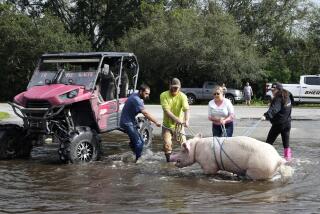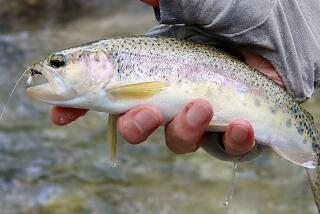Outlook Brighter for Everglades Recovery : Clinton asking millions more to save fragile wonder. Scientists agree on plans to restore the natural water flow.
- Share via
HOMESTEAD, Fla. — When Everglades National Park ranger Alan Scott leads visitors down the Anhinga Trail, he points out the alligators cruising by, the long-legged wading birds stalking mosquito fish and the saw grass, razor-sharp from here to the horizon.
But invariably Scott also stops alongside a depth gauge poking up out of the slough so that he can make a point about the lifeblood of the Everglades--water. “There are only two seasons here, wet and dry,” he recently told an attentive covey of tourists from all over the world.
“The water goes up and down naturally with the rainfall, and for thousands of years that has determined the life cycles of the plants and animals. But a lot of what affects the flow of water now happens outside the park boundaries. And that has caused problems.”
Of all the national park lands in the United States, none is closer to a major urban area or more beset with problems than the Everglades, a shallow, 50-mile-wide river of grass that flows south from Lake Okeechobee to Florida Bay. For more than a generation, this fragile natural wonder has been held hostage by a web of special interests--farmers, sportsmen and about 6 million South Florida residents in need of drinking water and flood control--that is as complex as the ecosystem itself.
The national park is 1.4 million acres, but that is just one-fifth of the wetlands ecosystem, and the destiny of lands inside and outside the park are linked. Pollution from agricultural runoff and a vast network of dikes and canals that has disrupted the natural flow of fresh water have pushed about 16 species of plants and animals onto the endangered list and plunged the whole Everglades system into crisis.
“The Everglades is a laboratory, and the whole world is watching how we do with the experiment going on here,” says environmentalist Joe Podgor of Friends of the Everglades. “The issues include toxic ground water, biodiversity, preservation of wetlands, endangered species, coral reefs and others. And there is a great sense of urgency.”
President Clinton has promised to make saving the Everglades a priority. In the budget presented Monday, he recommended doubling, to $57 million, the amount the Interior Department will spend on science and restoration.
Most scientists now agree on the plans for replumbing the Everglades to restore the natural sheet flow of water from the Kissimmee Valley, north of Lake Okeechobee, to Florida Bay. The Army Corps of Engineers has begun to free the Kissimmee River from the concrete channel to which it was confined 25 years ago, and an increase in water being pumped through the national park will eventually reduce the salinity of Florida Bay, an estuary where 100,000 acres of sea grass and millions of fish have died in the last 10 years.
Equally important, one of the state’s biggest sugar companies, Flo-Sun, last month agreed to pay $100 million over the next 20 years to help finance a cleanup estimated to cost $700 million. The company also agreed to refrain from further litigation blocking an earlier cleanup agreement between Big Sugar and the Clinton Administration.
Administration officials hope the Flo-Sun agreement will persuade U.S. Sugar and about 40 smaller growers to go along with the cleanup plan. The growers backed out of an earlier deal, saying it would take too much farmland out of production and cost up to 50,000 jobs. A trial on several farmers’ lawsuits blocking a cleanup plan is set for April 25.
But many environmentalists argue that the Administration is being too soft on Big Sugar, the source of phosphorous-based fertilizers that have encouraged the spread of exotic plants in the Everglades.
“Sugar has had everything it wants in the Everglades,” says Jim Webb, a former assistant U.S. secretary of the interior who now heads the Wilderness Society’s Everglades office. “The system has been operated so that the water tables suit agriculture, and they don’t even have to pay for it. The money (to run the water management system) comes from property taxes.”
Last September, Interior Secretary Bruce Babbitt climbed down from an airboat after a whirl through the Everglades, and in response to critics who accused him of caving in to Big Sugar, he sighed: “I’m a mere mortal. Maybe someone else can solve all the problems sooner . . . but nobody can expect to get 100% of everything.”
Out in the field, Scott says he sees evidence of the Everglades’ plight every day. In the deep pools where alligators congregate, exotic fish such as talapia and oscars outnumber the native bass and gar. Wading bird populations are down as much as 90% from when the park was created in 1947. “It’s frustrating,” Scott says. “There have been a lot of studies, a lot of talk, a lot of money spent and very little seems to have changed. Yet the Everglades are getting a lot of attention from various agencies, and even the visitors are pretty well up on the problems here. That’s encouraging. So we’ll see.”
More to Read
Sign up for Essential California
The most important California stories and recommendations in your inbox every morning.
You may occasionally receive promotional content from the Los Angeles Times.









